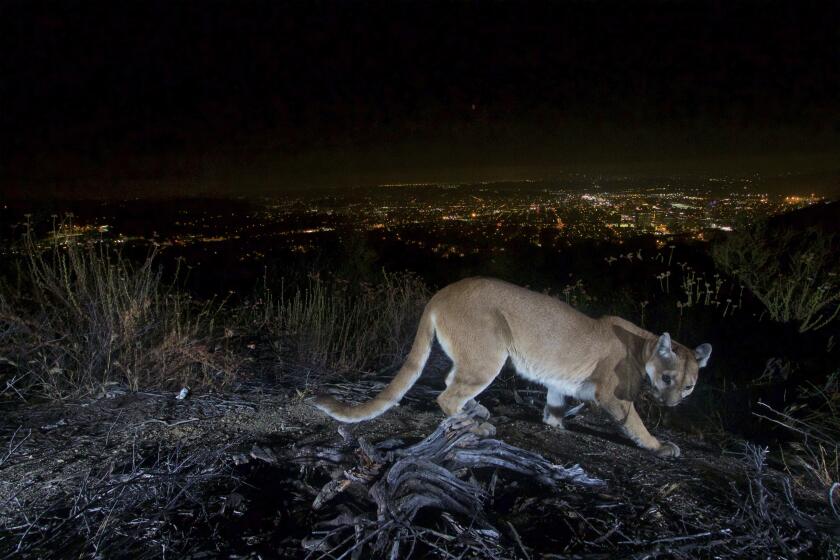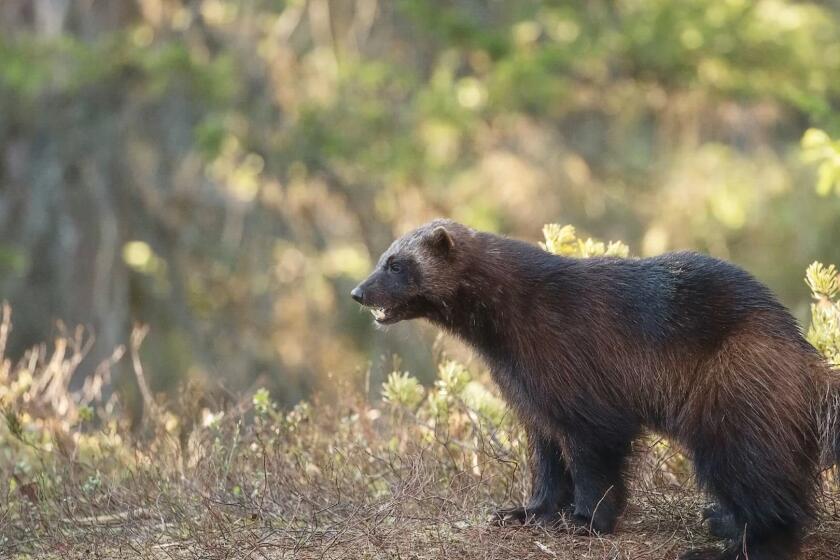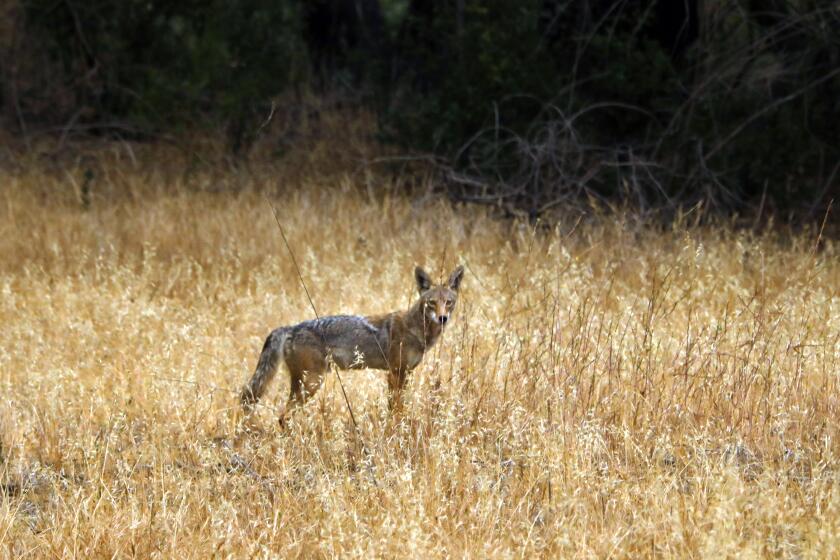Biologists Hatch New Plan for Condors
The recent deaths of three California condor chicks born in the wild is bringing a new, more hands-on management style to a program to save the rare birds. But critics say the changes do nothing to remedy fundamental flaws in the $35-million project.
Although condors have been coddled in captivity and closely monitored in the wild for two decades, the three turkey-sized chicks died last month. One had eaten everything from bottle caps to metal screws.
So now video cameras running 24 hours a day may be trained on nest sites. Food will be placed near caves to keep parents from foraging, and nests with eggs will be inspected for items that could kill young birds. And if biologists sense a problem, they will quickly intervene -- a major shift from a policy of steering clear of the chicks.
“Threats can be eliminated by intensive management,” said Bruce Palmer, who coordinates the condor recovery effort for the U.S. Fish and Wildlife Service. “How far we go can be debated, but we will do everything that is practical.”
Critics say the real problem is an emphasis on quantity over quality. They believe condors are released into the wild simply to boost numbers. And despite some recent successes, they say, the birds often cannot survive on their own, making the goal of an independent, wild population as far off as ever.
“You don’t have a self-sustaining population of condors out there and, unless they change their methodology, you won’t get one,” said David Clendenen, who spent 15 years as a top biologist with the program before resigning in frustration over its direction.
“How long do you keep pouring millions of dollars into something that is not sustainable?” he said. “I hate to say the birds are doomed; I love the condor. But I don’t see this trend turning around until something changes.”
Last month, just before their first flights, the first three condor chicks born in the wild since 1984 died in the Los Padres National Forest, dashing hopes for a new generation of wild condors.
One chick had swallowed a virtual junkyard. Pathologists found 12 bottle caps, electrical wiring, screws, washers, glass and plastic in its gizzard and stomach. Biologists are not sure whether the bird was born in a former raven’s nest, full of objects collected by the curious birds, or if the condor parents brought the items to the nest themselves.
The cause of death of the other two chicks remains under investigation, though both had foreign objects inside them. The father of one of the young birds is missing and presumed dead.
Disappointment also struck at the Grand Canyon earlier this year, when one condor egg failed to hatch and another was shattered, with the chick missing. A third egg was intentionally destroyed by an adult condor last year.
Those who raise and release condors say these are minor setbacks on the road to restoring the majestic, red-eyed vultures to their ancestral habitats. Their goal is two condor populations of 150 each in Arizona and California. There are now 74 condors in the wild and 126 in captivity.
“I don’t think any of these are surprising or discouraging, especially with captive birds,” said Bill Heinrich, species restoration manager for the Peregrine Fund in Boise, Idaho, which reintroduced condors to the Grand Canyon. “Sometimes it takes three nesting attempts to get it right. I think it’s lack of experience.”
But Noel Snyder, one of the pioneers of the condor program, thinks it’s more than that.
“The kinds of solutions they are proposing strike me as basically Scotch tape on a much more fundamental problem,” said Snyder, who headed condor restoration efforts for the Fish and Wildlife Service in the early 1980s.
He said condors have been tainted by their proximity to people. Rather than avoiding people, as their wild ancestors did, these birds often hang out near sites of human activity. As a result, condors have dunked themselves in oil, drunk antifreeze, landed in schoolyards, vandalized property and eaten lead bullets. In other cases, they have intentionally killed their chicks and formed bizarre love triangles.
Few of these activities were seen in the historic populations, Snyder said. His solution is drastic.
“The quantity-versus-quality argument hasn’t worked. The fundamental solution is to start over again with birds that have not had such a compromised early development in a zoo environment,” Snyder said. “You must limit releases to parent-reared birds that have never seen humans. They must be raised, not in zoos, but in field enclosures with no contact with people.”
Condors in the wild would be trapped and returned to captivity so as not to contaminate the others with their behavior.
“I don’t think this is admitting defeat,” Snyder said. “This is an expensive program, and the problems we see are continuous. I am optimistic about the program, and I would hate to give up before trying our best shot.”
Vicky Meretsky, assistant professor of conservation biology at Indiana University, said condors readily reproduce in captivity, but she worries that the current program has become a stocking operation. “I’d rather have a self-sustaining wild population,” she said.
Controversy over how best to manage North America’s largest bird has dogged the program from the beginning.
Some believed condors should be left alone, with biologists intervening only in emergencies. Others said that with so few condors left, it was vital to give them every advantage until they could build a sustainable population.
In the end, the highly managed philosophy won out.
Condor eggs and chicks are monitored around the clock at the Los Angeles and San Diego zoos and the Peregrine Fund.
Birds undergo behavioral training in captivity to avoid power poles.
Before release they are fitted with transmitters. Frozen calf carcasses are provided as food in the wild. The birds are tracked every day.
But as the recent deaths show, none of this ensures success.
“Murphy’s Law works overtime on this project,” said Mike Wallace, condor recovery team leader. “You have to adjust and create more remedies. You can only imagine how to bring back a species, until you try to do it. Quality versus quantity is such a trite way of painting what we are doing.”
He said numbers are critical to the long-term success of the birds. The more birds released, he said, the better the odds the species will survive.
Wallace, who helped reestablish Andean condors in South America, said biologists already recapture birds that get too close to humans or exhibit erratic behavior.
Next year, he plans to begin the type of experiment Snyder is calling for. Wallace hopes to put four pairs of condors in a remote pen on Ted Turner’s Ladder Ranch in southwestern New Mexico.
“We want parents to raise the chicks in isolation and have the chicks fledge into the wild,” he said. “This isn’t a new idea. We just didn’t have the money or expertise to do it before. I want to do this experiment and put this issue to rest.”
And like it or not, Wallace said, intensive management will continue for decades.
“How much do we manage? When can we back off? When can we stop being mothers out there?” he asked. “My answer is, ‘When we are done.’ And we are not done until we have a species out there living on its own.”
More to Read
Start your day right
Sign up for Essential California for news, features and recommendations from the L.A. Times and beyond in your inbox six days a week.
You may occasionally receive promotional content from the Los Angeles Times.






